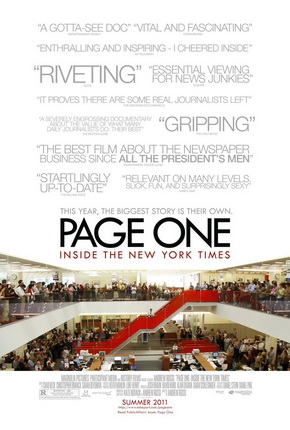Director Andrew Rossi attempts to profile one of the most well respected news outlets from the inside out in his new documentary Page One: Inside the New York Times. By following a handful of writers, reporters, and editors, the film chronicles the day to day activities of investigative journalism at it’s best, while showcasing the myriad of difficult choices that have to be made before printing the paper. The heart of the film is primarily concerned with an emerging debate about old media versus new media, traditional print versus online journalism, and ultimately how an established authority on the news grapples with staying relevant. While this is clearly a compelling and relevant issue to examine, the problem Page One faces is balancing the New York Times exposé with the questions of relevance, making the film feel unfocused.
For people obsessed with news, Page One will certainly be a tasty treat of journalistic juice. Delivering an unprecedented insider point of view of the mechanisms that determine what ends up on the front page, Rossi does an admirable job of tackling a layered organization by selectively examining a host of integral characters. Among them, the clear standout of interest is the intrepid media reporter David Carr, an elderly recovering drug addict who turned his life around and ended up in one of the most lauded positions at the company. His pointed questions, fiery passion for the newspaper, and respect for journalistic integrity is hard not to like and he definitely steals the show, earning a documentary spin-off for himself. His dramatic foil is in the form of 21-year-old new media whiz Brian Stelter who was plucked from the Internet to work at the company in order to inject a much needed dose of blogger personality to the more traditional approach of the Times.
The dynamic energy between these two principal reporters as they debate over their methods is the most engaging element of Page One. It strikes at the core of the debate that Rossi tries to bring the light regarding the relevance of an established journalistic entity in the face of social media driven reporting. The profiling of Iraq bound reporter Tim Arango and editor Bruce Headlam unfortunately seem more superficial, as their stories have less weight when framed against the rest of the issues presented in Page One. The upper echelon of the New York Times editorial board is also under developed and doesn’t reveal much besides showing up in large boardroom meetings. Bill Keller, executive editor of the newspaper, muses about the changing times, comparing the Watergate leaks to similar revelations from WikiLeaks, yet these comments do little to reveal the inner workings of important editorial decisions that should have been better examined if a true portrait of the New York Times was Rossi’s goal.
This dissonance strikes at the core problem that Page One faces in trying to handle the many issues that newspapers are burdened with today. The film feels like it’s divided into two halves, between profiling a large journalistic organization and tackling the old versus new media quandary, but never fully analyzing either. Rossi has a disarming fly on the wall style that never seems to challenge his subjects, opting for restrained observation which allows the audience to simmer in the tougher questions. Despite the persistent lack of a specific focus, Page One is an enjoyable and informative ride, especially for those obsessed with keeping their finger on the pulse.
Page One: Inside the New York Times is now in limited release.


